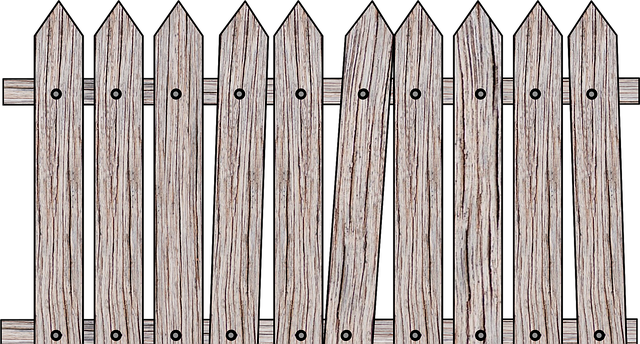Fences are integral to any property, offering both aesthetic appeal and functional benefits. To preserve their beauty and durability, regular staining and sealing become essential. This article guides you through every step of the process, from understanding the benefits and types of fence staining to preparing your wooden fence, choosing the right stain, mastering sealing techniques, following a step-by-step professional staining guide, and maintaining your newly stained fence to ensure it looks fresh for years to come.
- Understanding Fence Staining: Benefits and Types
- Preparing Your Wooden Fence for Staining
- Choosing the Right Stain: Color Options and Applications
- Sealing Techniques: Protecting Your Fence Long-Term
- Step-by-Step Guide to Professional Fence Staining
- Maintenance Tips: Keeping Your Stained Fence Looking New
Understanding Fence Staining: Benefits and Types
Fence staining is a popular method to enhance the appearance and protect wooden fences. It involves applying a pigmented solution that seeps into the wood, offering a range of aesthetic options from natural tones to vibrant colors. The process not only transforms the visual appeal but also provides several practical benefits.
There are various types of fence staining products available, each with unique characteristics. Water-based stains are popular for their low odor and easy application, while oil-based options offer deeper penetration and longer-lasting protection against water damage and UV exposure. Some advanced formulas even include UV inhibitors and mildewcides, ensuring the stained fence remains vibrant and durable for years.
Preparing Your Wooden Fence for Staining
Before applying any stain or sealer, preparing your wooden fence is crucial. Start by cleaning the fence thoroughly to remove any dirt, dust, mold, or mildew. Use a pressure washer or a brush and a mild detergent solution to ensure the surface is spotless. This step is essential as any debris can prevent the stain from adhering properly.
Next, inspect the wood for any damage such as splintered boards, rot, or cracks. Repair these issues before proceeding. Fill in any holes or cracks with a suitable filler, and sand the fence to create a smooth surface. This preparation ensures that your fence is in good condition and will provide an even application of the stain, enhancing its longevity and aesthetic appeal.
Choosing the Right Stain: Color Options and Applications
When choosing a fence stain, the first step is to consider the color options available. A wide array of shades are designed to enhance different types of wood grains and tones, ensuring your wooden fence stands out as an eye-catching feature in your landscape. From rich, deep browns that bring out the warmth of cedar to cool gray tones perfect for weathered planks, the possibilities are endless. Some stains also offer transparent options, allowing you to preserve the natural look of the wood while still providing protection.
The application of the stain is another factor to keep in mind. Water-based and oil-based stains have distinct properties and application methods. Water-based stains tend to be easier to use as they dry quickly and emit fewer odors, making them a popular choice for DIY projects. Oil-based stains, on the other hand, offer exceptional durability and penetrance, ensuring deeper color absorption and longer-lasting protection against elements like UV rays and moisture. The right stain will not only complement your fence’s natural beauty but also provide lasting protection.
Sealing Techniques: Protecting Your Fence Long-Term
When it comes to protecting your wooden fence, sealing is an essential step beyond regular staining. This crucial process creates a barrier between the wood and environmental elements, ensuring longevity and maintaining aesthetics. There are several sealing techniques to choose from, each offering unique benefits.
One common method is applying a water-repellent sealer, which fills in pores and small cracks, preventing moisture absorption. This is ideal for humid climates as it shields against rot and mold growth. Alternatively, an oil-based sealer penetrates deep into the wood, enhancing its natural color and providing excellent protection against UV rays. For those seeking a more durable solution, hybrid sealers combine water repellency with oil’s penetrance, offering both long-lasting protection and enhanced appearance.
Step-by-Step Guide to Professional Fence Staining
To achieve a professional fence stain, follow this step-by-step guide. Begin by cleaning your wooden fence thoroughly to remove any dirt, debris, or existing stains. This ensures better adhesion for the new coat of stain. Next, repair any damaged areas, such as split boards or loose nails, using appropriate wood repairs.
Once the fence is prepared, apply a primer designed specifically for wood. This helps to seal the surface and prepare it for staining. After the primer dries completely, choose your desired color of stain and apply it evenly using a brush, roller, or sprayer. Ensure even coverage by overlapping strokes in a crisscross pattern. Allow the stain to dry according to the manufacturer’s instructions before applying a protective sealant to safeguard against fading, weather damage, and UV exposure.
Maintenance Tips: Keeping Your Stained Fence Looking New
Regular maintenance is key to keeping your stained fence looking its best for years to come. After the initial staining process, it’s crucial to establish a cleaning routine, ideally once or twice a year, to remove any built-up dirt, mold, or mildew. Use a soft brush and a mild detergent solution to gently scrub the fence, focusing on areas with heavy traffic or exposure to elements like rain or direct sunlight. Avoid aggressive scrubbing, as it can damage the finish.
After cleaning, reapply a fresh coat of sealer every 2-3 years, depending on your climate and fencing material. This protective layer will shield the wood from moisture, UV rays, and other environmental stressors, prolonging the life of your stain and preserving the fence’s aesthetics. Regular maintenance ensures that your wooden fence not only remains visually appealing but also retains its structural integrity over time.
